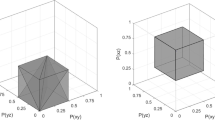Abstract
This paper studies the use of probabilistic expectations data to predict behavior in incomplete scenarios posed by the researcher. The information that respondents have when replying to questions posing incomplete scenarios is a subset of the information that they would have in actual choice settings. Hence such questions do not elicit pure statements of preference; they elicit preferences mixed with expectations of future events that may affect choice behavior. The analysis developed here assumes respondents recognize that their behavior may depend on information they do not have when expectations are elicited, and that they answer coherently and honestly given the information provided. The objective in imagining such ideal respondents is to place a logical upper bound on the predictive content of elicited choice expectations.
Similar content being viewed by others
References
Afriat, Sidney. (1967). ''The Construction of a Utility Function from Expenditure Data,'' International Economic Review 8, 67–77.
Beggs, S., Scott Cardell, and Jerry Hausman. (1981). ''Assessing the Potential Demand for Electric Cars,'' Journal of Econometrics 16, 1–19.
Ben-Akiva, Moshe and Thawat Morikawa (1990). ''Estimation of Switching Models from Revealed Preferences and Stated Intentions,'' Transportation Research A 24A, 485–495.
Blume, Lawrence, A. Brandenburger, and Edward Dekel. (1991). ''Lexicographic Probabilities and Choice Under Uncertainty,'' Econometrica 59, 61–79.
Dominitz, Jeff and Charles Manski. (1997a). ''Perceptions of Economic Insecurity: Evidence from the Survey of Economic Expectations,'' Public Opinion Quarterly 61, 261–287.
Dominitz, Jeff and Charles Manski. (1997b). ''Using Expectations Data to Study Subjective Income Expectations,'' Journal of the American Statistical Association 92, 855–867.
Dominitz, Jeff and Charles Manski. (1999). ''The Several Cultures of Research on Subjective Expecta-tions.'' In Robert Willis and James Smith eds., Wealth, Work, and Health Ann Arbor, MI: University of Michigan Press.
Fischer, Gregory and Daniel Nagin (1981). ''Random versus Fixed Coefficient Quantal Choice Models.'' In Charles Manski and Daniel McFadden eds., Structural Analysis of Discrete Data with Econometric Applications Cambridge, MA: MIT Press.
Fischhoff, Baruch, Ned Welch, and Shane Frederick. (1999). ''Construal Processes in Preference Assessment,'' Journal of Risk and Uncertainty, 19, 139–164.
Hurd, Michael and Kathleen McGarry. (1995). ''Evaluation of Subjective Probabilities of Mortality in the HRS,'' Journal of Human Resources 30, S268-S292.
Juster, F. Thomas. (1966). ''Consumer Buying Intentions and Purchase Probability: An Experiment in Survey Design,'' Journal of the American Statistical Association 61, 658–696.
Louviere, Jordan and G. Woodworth. (1983). ''Design and Analysis of Simulated Consumer Choice or Allocation Experiments: An Approach Based on Aggregate Data,'' Journal of Marketing Research 20, 350–367.
Luce, R. Duncan. (1959). Individual Choice Behavior: A Theoretical Analysis. New York: Wiley.
Luce, R. Duncan and Patrick Suppes. (1965). ''Preference, Utility, and Subjective Probability.'' In R. Duncan Luce, R. Bush, and E. Galanter eds., Handbook of Mathematical Psychology, Vol. 3. New York: Wiley.
Manski, Charles. (1975). ''Maximum Score Estimation of the Stochastic Utility Model of Choice,'' Journal of Econometrics 3, 205–228.
Manski, Charles. (1985). ''Semiparametric Analysis of Discrete Response: Asymptotic Properties of the Maximum Score Estimator,'' Journal of Econometrics 27, 313–333.
Manski, Charles. (1988). ''Identification of Binary Response Models,'' Journal of the American Statistical Association 83, 729–738.
Manski, Charles. (1990). ''The Use of Intentions Data to Predict Behavior: A Best Case Analysis,'' Journal of the American Statistical Association 85, 934–940.
Manski, Charles. (1995). Identification Problems in the Social Sciences. Cambridge, MA: Harvard University Press.
Manski, Charles. 1997. ''Monotone Treatment Response,'' Econometrica, 65, 1311–1334.
Manski, Charles and Ilan Salomon. (1987). ''The Demand for Teleshopping,'' Regional Science and Urban Economics 17, 109–121.
McFadden, Daniel. (1973). ''Conditional Logit Analysis of Qualitative Choice Behavior.'' In Paul Zarembka ed., Frontiers of Econometrics. New York: Academic Press.
McFadden, Daniel. (1976). ''Quantal Choice Analysis: A Survey,'' Annals of Economic and Social Measurement 5, 363–390.
Quadrel, M., Baruch Fischhoff, and W. Davis. (1993). ''Adolescent In vulnerability,'' American Psychologist 48, 102–116.
Tversky, Amos. (1972). ''Choice-by-Elimination,'' Journal of Mathematical Psychology 9, 341–367.
Varian, Hal. (1982). ''The Nonparametric Approach to Demand Analysis,'' Econometrica 50, 945–973.
Author information
Authors and Affiliations
Rights and permissions
About this article
Cite this article
Manski, C.F. Analysis of Choice Expectations in Incomplete Scenarios. Journal of Risk and Uncertainty 19, 49–66 (1999). https://doi.org/10.1023/A:1007806822876
Issue Date:
DOI: https://doi.org/10.1023/A:1007806822876




